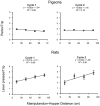Rats (Rattus norvegicus) and pigeons (Columbia livia) are sensitive to the distance to food, but only rats request more food when distance increases
- PMID: 22989930
- PMCID: PMC3532893
- DOI: 10.1016/j.beproc.2012.09.002
Rats (Rattus norvegicus) and pigeons (Columbia livia) are sensitive to the distance to food, but only rats request more food when distance increases
Abstract
Three experiments investigated foraging by rats and pigeons. In Experiment 1, each response on a manipulandum delivered food to a cup, with the distance between the manipulandum and the cup varying across conditions. The number of responses made before traveling to collect and eat the food increased with distance for rats, but not for pigeons. In Experiment 2, two manipulanda were placed at different distances from a fixed food source; both pigeons and rats preferentially used the manipulandum closest to the food source. Experiment 3 was a systematic replication of Experiment 1 with pigeons. In different conditions, each peck on the left key increased the upcoming hopper duration by 0.5, 1.5 or 2.5s. Completing a ratio requirement on the right key of 1, 4, 8, 16 or 32 pecks, depending on the condition, then produced the food hopper for a duration that depended on the number of prior left pecks. As the ratio requirement increased on the right key, pigeons responded more on the left key and earned more food. Overall, the results replicate previous research, underlining similarities and differences between these species. The results are discussed in terms of optimal foraging, reinforcer sensitivity and delay discounting.
Copyright © 2012 Elsevier B.V. All rights reserved.
Figures



Similar articles
-
An operant analog of food caching in the pigeon (Columba livia).Learn Behav. 2022 Mar;50(1):82-88. doi: 10.3758/s13420-021-00477-2. Epub 2021 Jul 21. Learn Behav. 2022. PMID: 34287804
-
Mechanisms underlying the effects of unsignaled delayed reinforcement on key pecking of pigeons under variable-interval schedules.J Exp Anal Behav. 1998 Mar;69(2):103-22. doi: 10.1901/jeab.1998.69-103. J Exp Anal Behav. 1998. PMID: 9540229 Free PMC article.
-
Effects of search cost on foraging and feeding: a three-component chain analysis.J Exp Anal Behav. 1984 Sep;42(2):211-21. doi: 10.1901/jeab.1984.42-211. J Exp Anal Behav. 1984. PMID: 6502067 Free PMC article.
-
Serial pattern learning: Pigeons (Columba livia) prefer an improving schedule over an initially easier fixed ratio schedule.J Comp Psychol. 2024 Nov;138(4):232-238. doi: 10.1037/com0000383. J Comp Psychol. 2024. PMID: 39680002
-
Animal procrastination: Pigeons choose to defer experiencing an aversive gap or a peck requirement.Learn Behav. 2020 Jun;48(2):246-253. doi: 10.3758/s13420-019-00397-2. Learn Behav. 2020. PMID: 31845110
Cited by
-
Spatial discrimination reversal and incremental repeated acquisition in adolescent and adult BALB/c mice.Behav Processes. 2015 Sep;118:59-70. doi: 10.1016/j.beproc.2015.06.005. Epub 2015 Jun 5. Behav Processes. 2015. PMID: 26051193 Free PMC article.
-
Captive chimpanzee foraging in a social setting: a test of problem solving, flexibility, and spatial discounting.PeerJ. 2015 Mar 17;3:e833. doi: 10.7717/peerj.833. eCollection 2015. PeerJ. 2015. PMID: 25802805 Free PMC article.
-
Applicability to foraging simulation of a reinforcement schedule controlling the response energy of pigeons.Learn Behav. 2013 Dec;41(4):425-32. doi: 10.3758/s13420-013-0117-7. Learn Behav. 2013. PMID: 23949926 Free PMC article.
References
-
- Ainslie G. Specious reward: A behavioral theory of impulsiveness and impulse control. Psych Bull. 1975;82:463–496. - PubMed
-
- Armitage D. Animal Diversity Web. University of Michigan Museum of Zoology; Ann Arbor: 2004. Rattus norvegicus (On-line) http://is.gd/LuUSEK.
-
- Bateson M, Kacelnik A. Rate currencies and the foraging starling - the fallacy of the averages revisited. Behav Ecol. 1996;7:341–352.
Publication types
MeSH terms
Grants and funding
LinkOut - more resources
Full Text Sources
Research Materials

